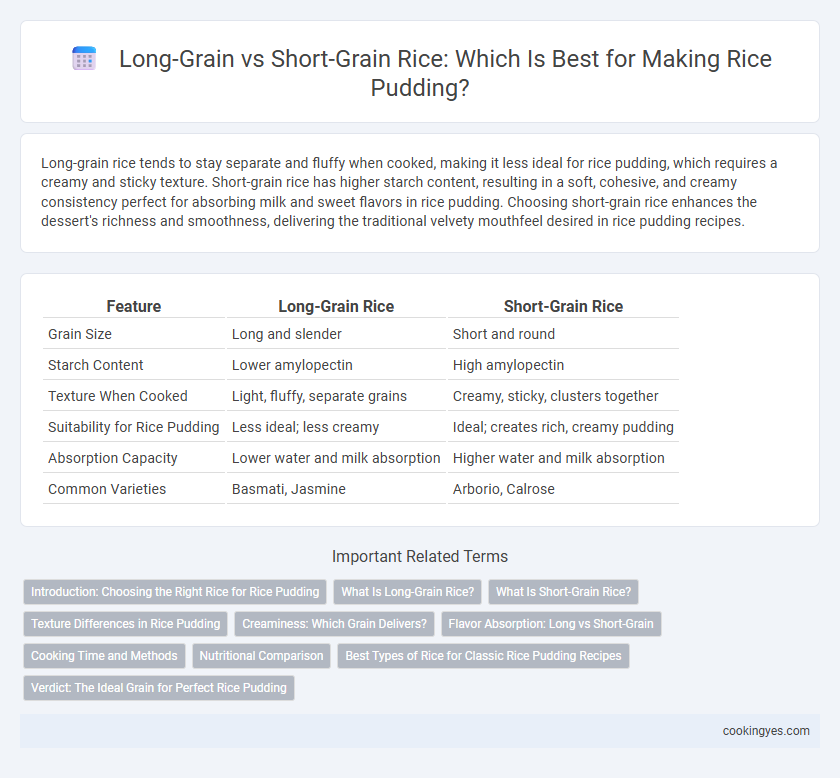Long-grain rice tends to stay separate and fluffy when cooked, making it less ideal for rice pudding, which requires a creamy and sticky texture. Short-grain rice has higher starch content, resulting in a soft, cohesive, and creamy consistency perfect for absorbing milk and sweet flavors in rice pudding. Choosing short-grain rice enhances the dessert's richness and smoothness, delivering the traditional velvety mouthfeel desired in rice pudding recipes.
Table of Comparison
| Feature | Long-Grain Rice | Short-Grain Rice |
|---|---|---|
| Grain Size | Long and slender | Short and round |
| Starch Content | Lower amylopectin | High amylopectin |
| Texture When Cooked | Light, fluffy, separate grains | Creamy, sticky, clusters together |
| Suitability for Rice Pudding | Less ideal; less creamy | Ideal; creates rich, creamy pudding |
| Absorption Capacity | Lower water and milk absorption | Higher water and milk absorption |
| Common Varieties | Basmati, Jasmine | Arborio, Calrose |
Introduction: Choosing the Right Rice for Rice Pudding
Long-grain rice has firm, separate grains ideal for pilafs but is less suitable for rice pudding due to its lower starch content, which results in a less creamy texture. Short-grain rice contains higher amylopectin starch, producing a stickier, creamier consistency perfect for traditional rice pudding recipes. Selecting short-grain rice enhances the pudding's smoothness and richness, ensuring a classic, velvety dessert experience.
What Is Long-Grain Rice?
Long-grain rice features slender grains that remain separate and fluffy when cooked, making it less sticky than short-grain varieties. Its lower amylopectin content results in a drier texture, which is ideal for pilafs but less suited for creamy rice pudding. For rice pudding, short-grain rice is preferred due to its higher starch content that produces a soft, cohesive texture.
What Is Short-Grain Rice?
Short-grain rice is a type of rice characterized by its plump, almost round grains and sticky texture when cooked, making it ideal for creamy dishes like rice pudding. Its high starch content, particularly amylopectin, allows it to absorb more liquid and create a smooth, custard-like consistency. In contrast to long-grain rice, short-grain rice clumps together better, enhancing the pudding's rich and velvety mouthfeel.
Texture Differences in Rice Pudding
Long-grain rice creates a light, fluffy texture in rice pudding due to its lower starch content, resulting in distinct, separate grains. Short-grain rice produces a creamy, sticky texture because of its higher amylopectin levels, which release more starch during cooking. This starchiness enhances the pudding's smoothness and thickness, making short-grain rice preferable for rich, velvety rice pudding.
Creaminess: Which Grain Delivers?
Short-grain rice delivers a creamier texture for rice pudding due to its higher amylopectin content, which results in increased starch release during cooking. Long-grain rice grains remain separate and less sticky, producing a firmer pudding consistency. For maximizing creaminess in rice pudding, short-grain rice varieties like Arborio or sushi rice are preferred choices.
Flavor Absorption: Long vs Short-Grain
Short-grain rice excels in flavor absorption due to its higher starch content, resulting in a creamier and more cohesive rice pudding texture. Long-grain rice tends to remain firmer with separate grains, absorbing less liquid and flavor, which creates a drier, less integrated dessert. Choosing short-grain rice maximizes flavor infusion and achieves the traditional rich, smooth consistency desired in rice pudding.
Cooking Time and Methods
Long-grain rice requires a longer cooking time of about 18-20 minutes, maintaining a fluffy texture ideal for rice pudding that benefits from absorbent grains. Short-grain rice cooks faster, typically in 15-18 minutes, producing a creamier, stickier consistency perfect for rich, smooth pudding varieties. Using simmering or gentle boiling methods optimizes starch release, crucial for achieving the desired pudding texture with either rice type.
Nutritional Comparison
Long-grain rice contains slightly fewer calories and carbohydrates than short-grain rice, making it a lighter option for rice pudding. Short-grain rice has a higher starch content, contributing to a creamier texture and increased digestibility due to its amylopectin levels. Both varieties provide essential nutrients like B vitamins and minerals, but short-grain rice offers a modestly higher glycemic index, influencing blood sugar response.
Best Types of Rice for Classic Rice Pudding Recipes
Long-grain rice offers a fluffy texture with distinct grains, ideal for rice dishes but less suitable for creamy rice pudding. Short-grain rice, especially varieties like Arborio or Japonica, absorbs more liquid and releases starch, creating the rich, creamy consistency perfect for classic rice pudding recipes. Using short-grain rice enhances the dessert's smoothness and traditional texture.
Verdict: The Ideal Grain for Perfect Rice Pudding
Long-grain rice has a firm texture and separate grains, making it less suitable for creamy rice pudding. Short-grain rice contains higher starch content, which thickens the pudding and creates a smooth, velvety consistency essential for perfect rice pudding. Therefore, short-grain rice is the ideal grain choice for achieving the traditional richness and creaminess in rice pudding recipes.
Long-grain rice vs Short-grain rice for rice pudding Infographic

 cookingyes.com
cookingyes.com